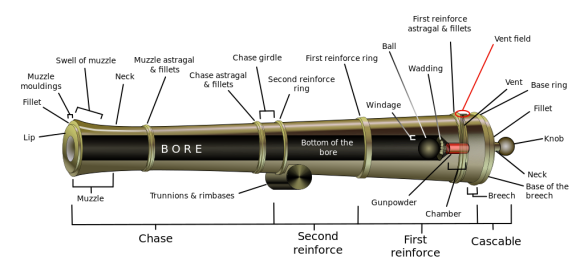
When circumstances make it necessary to abandon cannon, or when the enemy’s artillery is seized, and it is not, however, possible to take them away, it is proper to nail them up, which is done by driving a large nail or iron spike into the vent of the pieces of artillery, which is a momentary business and renders them unserviceable, at least for awhile.
A 24-pounder, can be nailed with a square nail 8.52 inches long and .27 inch square, with a swelling at the head: one minute is sufficient to drive it into the vent.
The same can be nailed with a nail 8.52 inches long, .36 inch square in the middle and .44 or .56 inch at the head: it is not easy to drive this nail up to the head.
The same can be likewise be nailed with a steel pointed nail, cut in the form of a male screw, .48 inch diameter, and 7.46 inches long; and tempered in its whole length, exclusive of the point, that it may be riveted inside. This method is by far the best but it is long and requires two hours and a quarter to perform it.
In order to increase the obstacles, after the cannon is nailed, the bottom is filled with potter’s clay or with a cylinder of hard wood, and a calibre shot, muffled in felt, or in a piece of old hat, is strongly rammed above it.
There are various contrivances to force the nail out. In the two first instances, it is sometimes possible to remedy this accident, by loading the gun with a charge somewhat more than one-third the weight of the shot, for instance ten pounds and a half for a 24-pounder, ramming on the charge a wad mixed with powder and matches: then putting one shot, or a wooden cylinder. We would rather advise a cylinder of fat clay to increase the resistance to the explosion, and consequently, render the action of the powder greater in the vent. In all cases a strong wad should be rammed on the shot or cylinder. The fire is communicated to a match, which from the mouth of the cannon, reaches the charge; but sometimes this operation is to be renewed more than once, before the nail can be forced out. Great attention must be paid that no sand or small stones remain in the rammer, before making use of it.
But all attempts in general are useless when the piece is well spiked as in the third instance; and the piece must either be melted again, or, if it be worth the trouble, repaired in the same way as damaged vents.
If the nail be screwed in, the best method is to drill a new vent next to the other.
When the nail is forced out, or a new vent drilled, it becomes as easy matter to disengage the bore of all internal obstacles, by introducing a sufficient quantity of powder through the vent, in these cases the spiking of cannon is but a temporary accident.